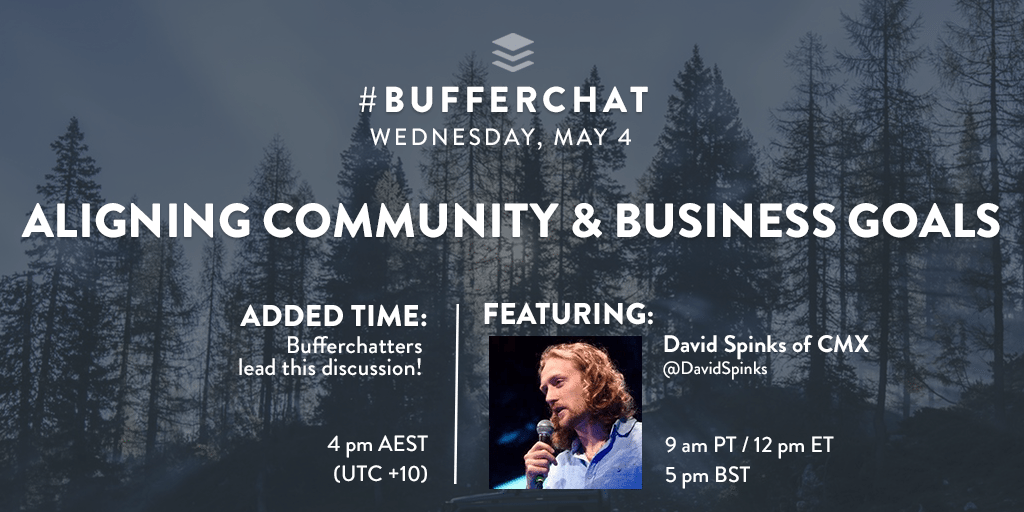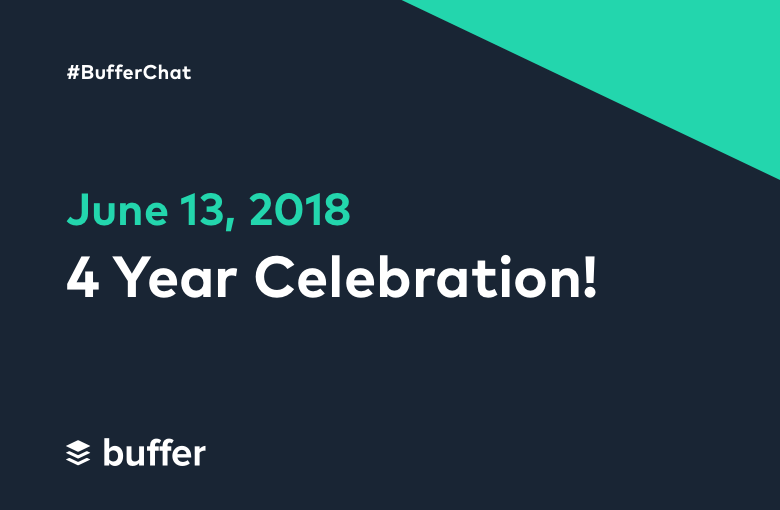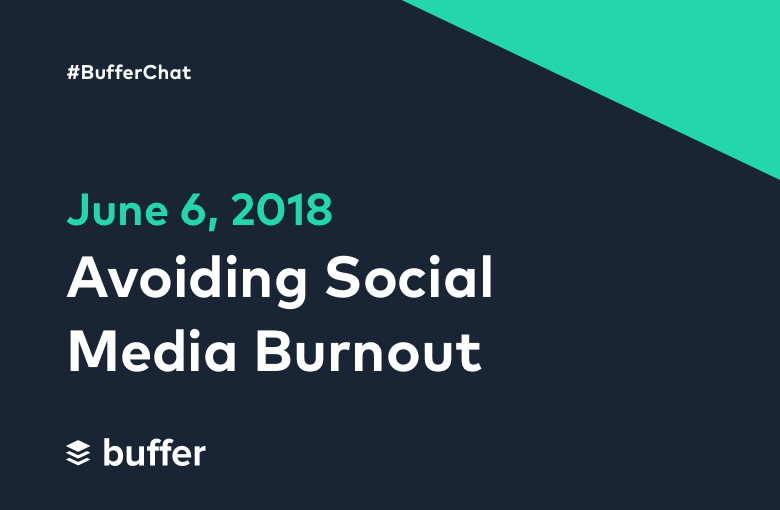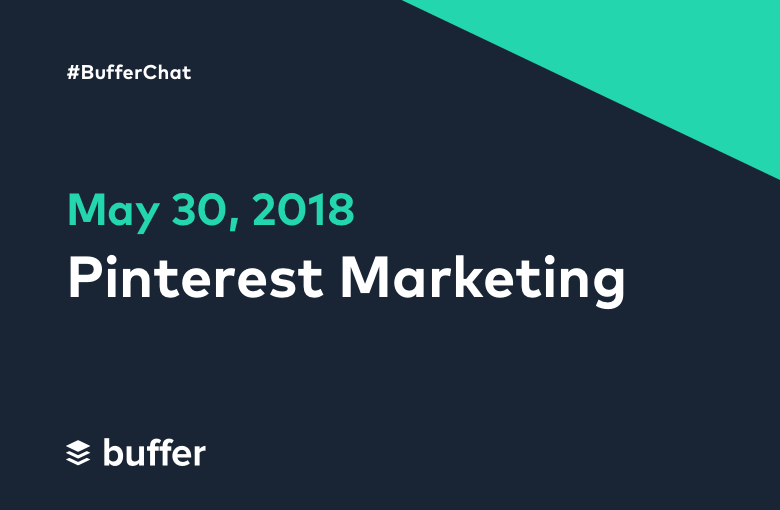
Aligning Community & Business Goals: A Bufferchat Recap
This week, David Spinks (the founder and CEO of CMX) stopped by #bufferchat to share his insights about aligning community and business goals – the why, the how and everything in between!
Catch our weekly Twitter chat, #bufferchat, at TWO times every Wednesday for valuable industry insights and networking with nearly 400 other smart marketers and community managers. Same topic, same place, just at different times – feel free to join in to whichever chat time works best for you!
For our community in Asia and Australia (or anyone in other timezones that like this time the best!): 4 pm AEST (Sydney time, UTC+10)
For our community in North/South America, Europe and Africa (or others!): 9 am PT (California time)

Q1: How would you define the role of community within business?
From David:
- Businesses ARE communities. Your team is a community. Your community is part of your team.
- It’s important to define what community is – a group of people with a sense of belonging around a common identity.
- When a business builds community, they’re embracing the concept of decentralization and distributing control to people.
- So when a business builds community, instead of creating all the value, they empower people to create value for each other.
- Community can’t just be an add on. You have to truly believe that it’s a better way to build business.
- Community isn’t just about connecting with customers. That’s one step. Ultimately, you have connect them with each other.
- Community is a LONG TERM play. Won’t have the same immediate results as ads/marketing. We’re talking decades of brand value.
- So stop limiting “collaboration” to your employees. There’s incredible value in treating your community as part of the team.
- Our research showed that the #1 reason communities fail is lack of internal support. You MUST have executive buy in.
From the community:
- “Community plays a crucial role of influencer, accreditation, loyalty and voice within business.” @anandan22
- “Should be the foundation of business, the employee comm builds the business and the customer comm gives it purpose.” @LauraUlrick
- “Community is everywhere. Like the nervous system to a business.” @mrkampmann
- “Social media has turned customers into a community, where people learn from each other and can support your brand.” @martinlieberman
- “An enthusiastic and engaged community is the reflection of how effective a company’s message is across a designated audience.” @Lynniepenguin
See all the great answers to question 1 here!
Q2: What are some ways a community team can support other departments within a company?
From David:
- We use the SPACE Model to identify where community fits in a biz – Support, Product, Acquisition, Content, Engagement.
- If you’re interested in learning more about the SPACE model check this out.
- Community can contribute to customer support and success by empowering customers to help each other.
- Community contributes to Product by driving product ideation and innovation from community members.
- According to MIT, community is one of the primary catalysts of innovation, resulting in up to 37% increase in performance.
- Community contributes to acquisition and marketing by empowering community members to be brand ambassadors.
- Community contributes to content by crowdsourcing from community members (ie.
@ProductHunt,@duolingo). - And community can be it’s own department, focused purely on driving engagement that improves retention and customer LTV.
From the community:
- “Acting as a voice for customer feedback &making sure positives, suggestion & complaints reach appropriate parties.” @GallowsHumor7
- “The community team can help every department understand what their target audience loves and help them cater to that passion.” @BillWidmer1
- “Community teams can foster conversations that actively feed information into challenges departments face. ex: product dev.” @MaureenOnPoint
- “Community can be a glue. To motivate others, cross bridges and getting people to ACT, to bond, to DO.” @ZalkaB
- “It can deliver a different perspective & game changing insights. The return on collaboration for other depts will be good.” @ideakid88
See all the great answers to question 2 here!
Q3: How can you encourage/justify a focus on community to managers/CEOs who may not be fully on board?
From David:
- GREAT question because according to
@cmx research lack of internal support is the #1 reason community strategies fail. - Our research showed that internal support came from identifying a business need that community could specifically help with.
- Highly recommend reading our research to better understand how companies are investing in community.
- You have to put community in the context of the metrics and goals that your business already has.
- You also want to identify where community fits into the customer journey and marketing funnels. How will it contribute?
- But heres the harsh reality: If the CEO and execs don’t truly believe in the long term value of community, you’ll prob fail.
- Great examples of community ambassador programs:
@theskimm@lululemon@hootsuite@googledevs@creativemorning. - Yeah if you’re having trouble convincing your boss, send them to us.
@CMX will straighten em out ?
From the community:
- “Provide them with research that shows how effective it can be and just ask for the chance to prove it.” @sweetlifeofash
- “Give them an example of when community “converted” you on a sale. Ask for an experience of theirs.” @lilfrankie_13
- “Community is the most cost effective method of marketing, sales & customer service. Basis for referrals, word of mouth.” @joshmccormack
- “Show the C-suite what they’re competitors are doing. They’ll want to win the
#social game when they see others are playing.” @KristiKellogg - “Talk about bottom line. Show financial gains & opportunities by having community & social advocates. Use real case studies.” @GeoffTBlosat
See all the great answers to question 3 here!
Q4: What are your go-to, essential metrics for tracking the ROI of community?
From David:
- In order to identify the ROI of community, you first have to identify the business need it’s focused on (why we use SPACE).
- The metrics you use for a support community are entirely different from the metrics you use for an acquisition community.
- We encourage measuring three levels of metrics: Community Health + Business Objectives + ROI.
- Community has 2 kinds of value: 1 Value of Member (retention/LTV) 2 Value of Member Contributions (support/referrals/content).
- ROI can take a long time to prove our for community. Need 6 months at a bare minimum. Better would be 12 months.
@CMX research: Main 2 reasons orgs invest in community is to impact customer satisfaction/retention and to drive innovation.
From the community:
- “Depends on the company. Right now we look at growth, retention and activity that helps others (accepted solutions).” @sherrierohde
- “We track implementation time & cost reduction & compare that to historical trends or best in class benchmarks if they exist.” @RCPatchett
- “Some engagement metrics: event attendance, content sharing, likes (that’s not vanity, that’s resonance).” @chrissachrissa
- “Net promoter score & referrals. Build trust with your community AND they will share their love!” @bestcapetownSA
- “Two additional returns from investing in community that cannot be so easily measured: happiness and loyalty.” @stephanniebee
See all the great answers to question 4 here!
Q5: What are some examples of a community impacting a company or product?
From David:
- I have so many examples! I’d recommend browsing the CMX case studies section for more depth: http://cmxhub.com/browse.
- the
@Vimeo community is a core part of their product development and innovation process. [see blog post] - Here’s how Salesforce proved the ROI of community with their MVP program. [see blog post]
@ProductHunt redefined how products are launched and discovered by empowering a community. [see blog post]@duolingo has empowered millions to learn a new language and ALL courses are developed by the cmty. [see blog post]@Dell created the Dell Ideastorm platform where the community shares ideas. An idea is valued at $10,000 to Dell.- TheSkimm sees something like 18% of their signups come directly from their ambassador program.
- There are so many more good examples.
@airbnb,@lyft,@generalelectric,@nike,@Sephora all have community programs.
From the community:
- “Pick any successful company/ brand you want, at their core, is a community who share passion, loyalty, & genuine engagement!” @anthonydlarsen
- “@Twitch – the product was built on a passionate community, both in viewers & content producers.” @mwilton13
- “Ola is a platform just like Uber here in India which launched boat services in Chennai during floods.” @varun2816
- “
@reddit
Twitch are communities have a HUGE say in business successes. @moz @semrush communities are vocal about feedback.” @katbu
- “Customer feedback! Making product tweaks from ideas from users. Showing people you listen also builds loyalty.” @miro_cassetta
See all the great answers to question 5 here!
Q6: How can you measure the “health” of your community?
From David:
- LOVE talking about measuring health of community because there’s a lot more info there.
- Keep it simple when you’re starting to measure health of community. In our training we recommend: Growth + Repeat Activity.
- If you want to get more scientific with measuring community health try the Sense of Community Index.
- Put simply, a community is usually healthy if it’s growing (not churning) and members are coming back over time.
- Also look into the social identity theory and ask, are your members forming a social identity?
- Remember that in all communities MOST of the value will be created by a small percentage of members.
From the community:
- “Definitely when your community start self-sustaining itself & growing without you having to do anything. :)” @luciemontel
- “Also, if your community is rallying around one another – you know it’s strong. It’s the little things like happy birthday.” @CBarrows
- “Sentiment. Are most of the conversations negative/positive? Actually interact with your community to keep it healthy!” @emily_triplett3
- “Are people engaging? Are they listening? Are they responding? If not, something needs to change!” @ExpWriters
- “Measure the health of your community by the engagement between members – not just with yourself.” @MSLJim
See all the great answers to question 6 here!
Q7: What are some valuable goals for community teams to set?
From David:
- Your goals all depend on what the focus of your community is and where you fit in the SPACE model.
- Usually community pros set goals to: 1. Achieve business objectives 2. Grow the community 3. Maintain a level of activity.
- Your main goal, just like in product dev, is to LEARN. It’s ok if you try something and fail as long as you learn and adapt.
- Community is an experiment. Do your research of members’ needs, form a hypothesis, and test it out.
- Your goal as a professional community builder should be to hit business KPI’s and maintain a healthy active community.
- If you’re a support focused community, your goals will be around customer success, quality and immediacy of support.
- If your community is focused on product, your goals will be around driving the sharing of quality ideas and feedback.
- If your community is focused on acquisition, your goals will be around finding more ambassadors and driving growth.
- If your community is focused on content, your goals will be around the quality and frequency of content contributions.
- Finally, if your community is focused on engagement, your goals will be around retention and loyalty.
- For ALL community programs, your goal is to build a healthy, active community but that only matters if you achieve biz goals
From the community:
- “Being responsive in a timely manner to questions & comments. Measuring feedback & responding appropriately.” @BrightHausGroup
- “Some of the goals I’ve used incl increase in participation and product ideas/feedback submitted.” @SFerika
- “I think a great goal is to take conversations offline. Phone chats with members of your community are fun + invaluable.” @ericajmoss
- “Improve community and team happiness. Trying to grow, but more importantly, maintain and enhance the current community.” @FredPaulussen
- “I love to include personal growth in our team goals – I believe it strengthens all we do! :)” @nmillerbooks
See all the great answers to question 7 here!
—
Thank you so much to David for sharing his awesome insights and to everyone who participated in this awesome chat!
Catch #bufferchat each Wednesday at 9 am PST, 12 pm EST, 5 pm BST (GMT+1) **OR** at 4 pm AEST (Sydney time, UTC+10). Join our new Slack community with over 1,000 members to continue these awesome conversations all week long!
Do you have any comments or answers to these questions? Leave your thoughts in the comments! We’d love to hear from you!
Image sources: UnSplash
Try Buffer for free
140,000+ small businesses like yours use Buffer to build their brand on social media every month
Get started nowRelated Articles

We’ve decided to retire #bufferchat after four years and had a celebration with our community, Read on to discover all of the memories and fun shared during the chat! This week’s stats: Bufferchat (9 am PT): 118 participants; reach of 1,655,682 Q1: What’s been your favorite #bufferchat topic? From the community: A1: There’s been so many great #bufferchat that resonated with me. Standouts include: ✅Email Marketing with @p

This week on #bufferchat our community shared all the best tips and tricks to avoid social media burnout. Read on to discover all of the awesome insights shared during the chat! Catch our weekly Twitter chat , #bufferchat, at TWO times every Wednesday for valuable industry insights and to meet hundreds of other smart marketers and social media enthusiasts. Same topic, same place, just at different times – feel free t

This week on #bufferchat our community discussed the ins and outs of marketing on Pinterest. Read on to discover all of the awesome insights shared during the chat! Catch our weekly Twitter chat , #bufferchat, at TWO times every Wednesday for valuable industry insights and to meet hundreds of other smart marketers and social media enthusiasts. Same topic, same place, just at different times – feel free to join